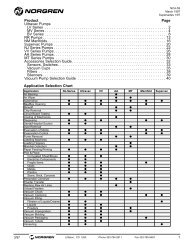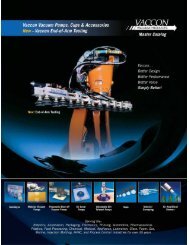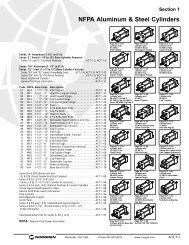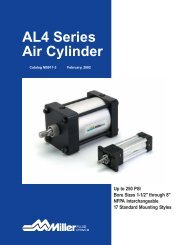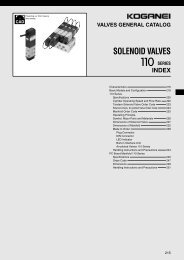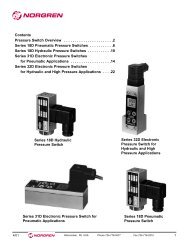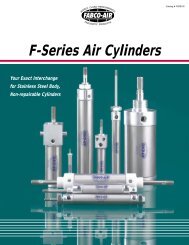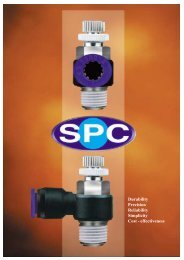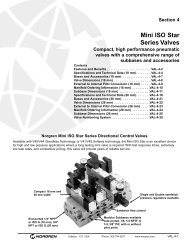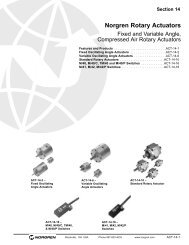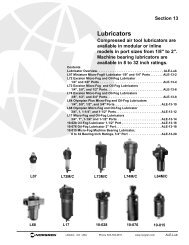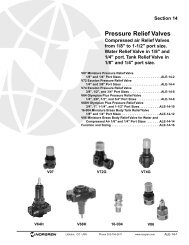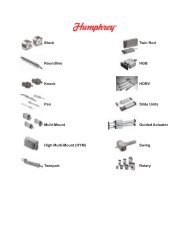Series CHL/CHH - Warden Fluid Dynamics
Series CHL/CHH - Warden Fluid Dynamics
Series CHL/CHH - Warden Fluid Dynamics
Create successful ePaper yourself
Turn your PDF publications into a flip-book with our unique Google optimized e-Paper software.
Catalog M1136Cylinder Division Safety GuidelinesCompact Hydraulic Cylinders<strong>Series</strong> <strong>CHL</strong> & <strong>CHH</strong>Cylinder Division Safety Guidelines for Selecting and Using the <strong>CHL</strong> and <strong>CHH</strong> Hydraulic CylindersWARNING: FAILURE OR IMPROPER SELECTION OR IMPROPER USE OF CYLINDERS AND THEIR RELATEDACCESSORIES CAN CAUSE DEATH, PERSONAL INJURY OR PROPERTY DAMAGE.Before selecting or using cylinders or relatedaccessories, it is important that you read, understand,and follow the following safety information.User ResponsibilityDue to a very wide variety of cylinder applications andcylinder operating conditions, Cylinder Division does notwarrant that any particular cylinder is suitable for any specificapplication. The safety guide does not analyze all technicalparameters that must be considered in selecting a product.The hydraulic cylinders outlined in this catalog are designedto Cylinder Division design guidelines and do notnecessarily meet the design guidelines of other agenciessuch as American Bureau of Shipping, ASME PressureVessel Code, etc. The user, through his own analysis andtesting, is solely responsible for:• Making the Final selection of the cylinders and relatedaccessories.• Determining if the cylinders are required to meet specificdesign requirements as required by the Agency(s) orindustry standards covering the design of the user’sequipment.• Assuming that the user’s requirements are met, OSHArequirements are met, and safety guidelines from theapplicable agencies, such as, but not limited to, ANSI, arefollowed and that the use presents no health or safetyhazards.• Providing all the appropriate health and safety warningson the equipment on which the cylinders are used.SealsThe application of cylinders may allow fluids such as cuttingfluids, wash-down fluids, etc., to come in contact with theexternal area of the cylinder. These fluids may attack thepiston rod wiper and or primary seal and must be taken intoaccount.Dynamic seals will wear. The rate of wear will depend onmany operating factors. Wear can be rapid if a cylinder ismisaligned or if the cylinder has been improperly serviced.The user must take seal wear into consideration in theapplication of the cylinders.• Failure of the pressurized fluid delivery system (hoses,fittings, valves, pumps, compressors) which maintaincylinder position.• Catastrophic cylinder seal failure leading to sudden lossof pressurized fluid.• Failure of the machine control system.A lateral or eccentric load cannot be applied to the cylinderpiston rod without causing permanent damage to the cylinder.Careful attention must be paid to cylinder alignment uponinstallation. If these types of additional loads are expected tobe imposed on the piston rod, their magnitude should bemade known to our Engineering Department.For the maximum permissible piston impact speed, pleaserefer to the “Permissible Energy of Inertia” chart.The cylinder user should always make sure that the piston rodis securely attached to the machine member.On occasion, cylinders are ordered with double rods (a pistonrod extending from both ends of the cylinder). In some cases,a stop is threaded on to one of the piston rods and used as anexternal stroke adjuster. On occasions, spacers are attachedto the machine member connected to the piston rod, and alsoused as a stroke adjuster. In both cases, the stops will createa pinch point and the user should consider appropriate use ofguards. If these external stops are not perpendicular to themating contact surface, or if debris is trapped between thecontact surfaces, a bending moment will be placed on thepiston rod, which can lead to piston rod failure. An externalstop will subject the piston rod to impact loading. These two(2) conditions can cause piston rod failure. The use ofexternal stroke adjusters should be reviewed with ourengineering department.Port FittingsHydraulic cylinders applied with meter out or decelerationcircuits are subject to intensified pressure at the piston rodend. The rod end pressure is approximately equal to:operating pressure x effective cap end areaeffective rod end piston areaContact your connector supplier for the pressure rating ofindividual connectors.Piston RodsPossible consequences of piston rod failure or separation ofthe piston rod from the piston include, but are not limited to,are:• Piston rod and/or attached load thrown off at high speed.• High velocity fluid discharge.• Piston rod extending when the pressure is applied in thepiston retract mode.Piston rods or machine members attached to the piston rodmay move suddenly and without warning as a consequenceof other conditions occurring to the machine such as, but notlimited to:• Unexpected detachment of the machine member fromthe piston rod.Cylinder Modifications or RepairsCylinders as shipped from the factory are not to bedisassembled and or modified. If cylinders requiremodifications, these modifications must be done at Miller<strong>Fluid</strong> Power locations or by Miller <strong>Fluid</strong> Power certifiedfacilities. It is allowed to disassemble cylinders for thepurpose of replacing seals or seal assemblies. However, thiswork must be done by strictly following all the instructionsprovided with the seal kits.Mounting RecommendationsAlways mount cylinders using the largest possible hightensile alloy steel socket head screws that can fit in thecylinder mounting holes and torque them to the manufacturer’srecommendations for their size. Refer to theInstallation and Maintenance page.19Miller <strong>Fluid</strong> PowerDes Plaines, ILToronto, Ontario Canada



